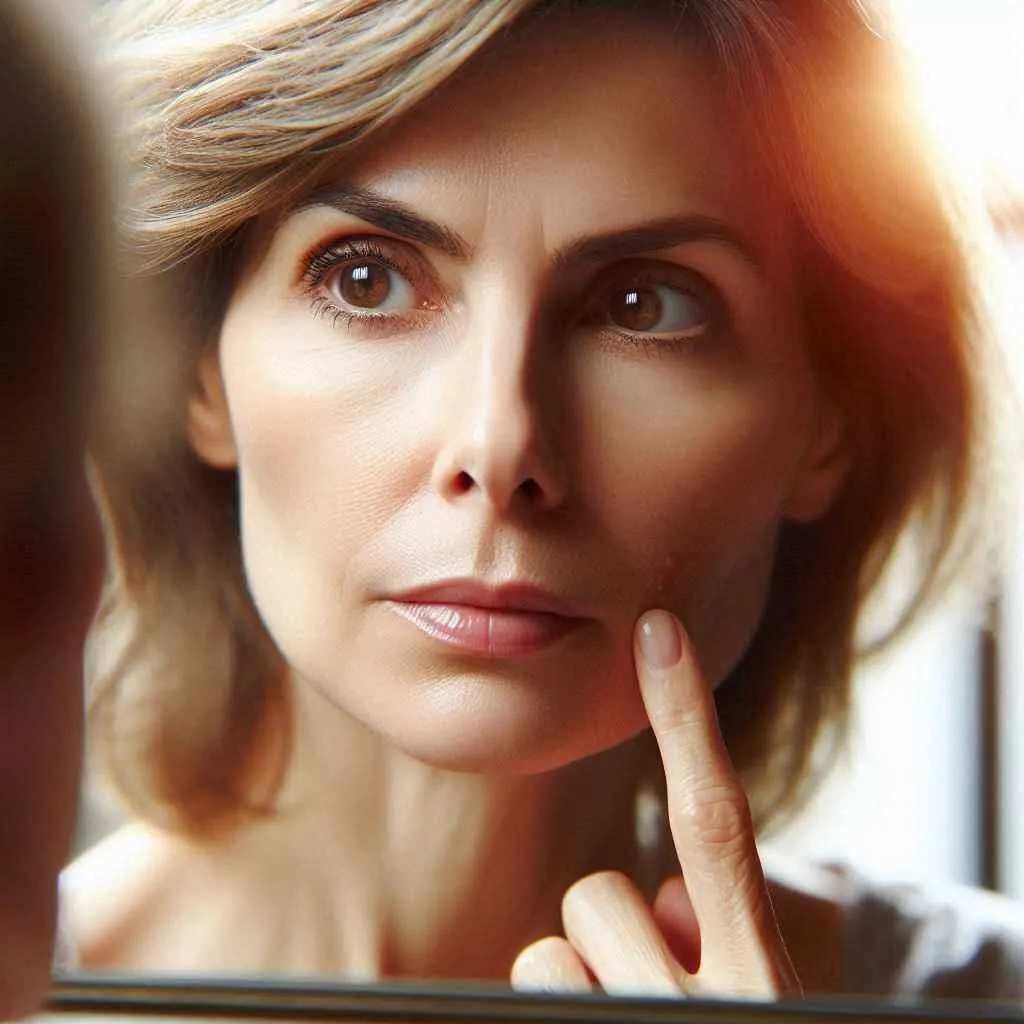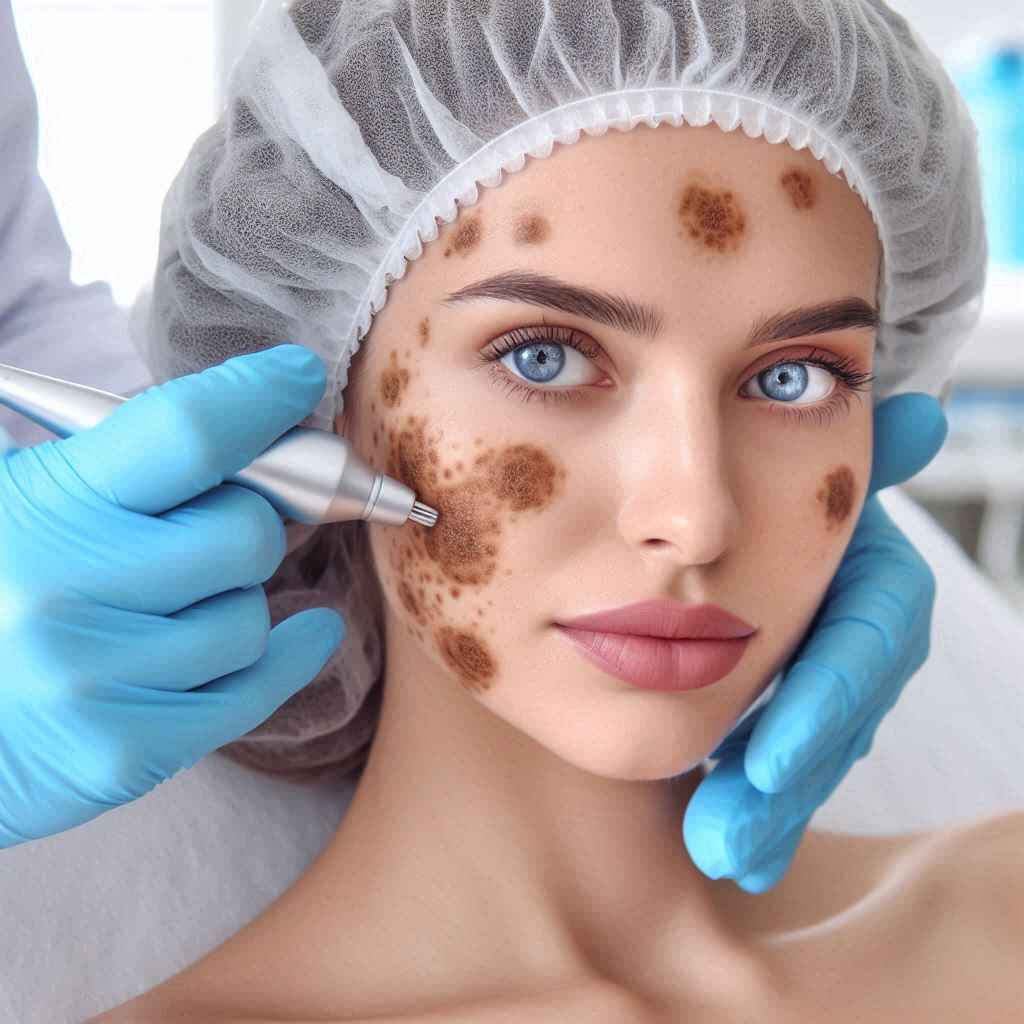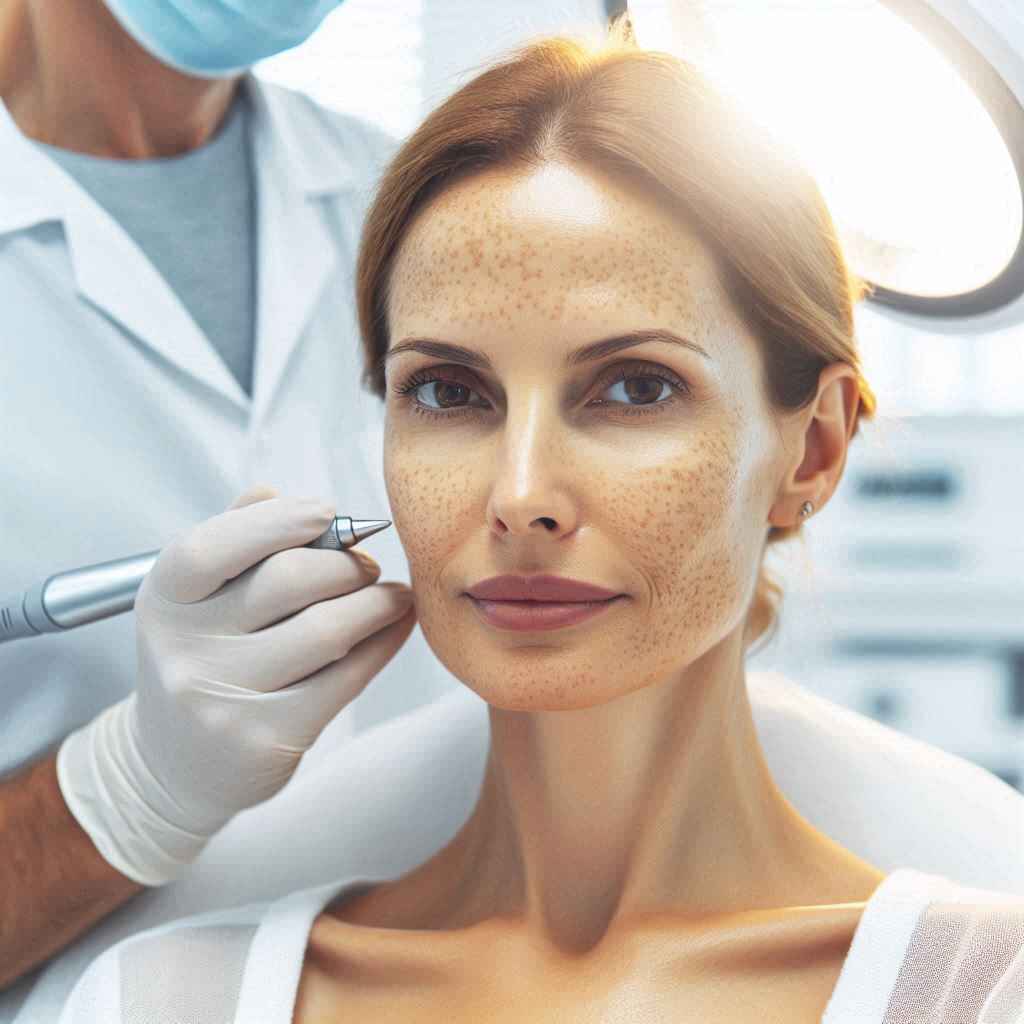St. Pete Location
Bradenton Location
Patient Education
We're passionate about helping people achieve their healthiest, happiest skin. Whether you're struggling with acne, eczema, rosacea, or any other skin concern, we're here to offer support, information, and inspiration.

Age Spots: Causes, Prevention, and Effective Treatments
Age spots, also known as liver spots or solar lentigines, are a common skin concern that affects many people as they grow older (1). These flat, dark patches typically appear on areas of the skin that have been exposed to the sun over time. While age spots are generally harmless, they can be a source of cosmetic concern for many individuals.
Understanding Age Spots
What Are Age Spots?

Age spots are flat, oval areas of increased pigmentation that typically appear on sun-exposed skin. They range in color from light brown to black and are most commonly found on the face, hands, shoulders, and arms (2). Despite their name, age spots are not necessarily a result of aging alone but are primarily caused by cumulative sun exposure over the years.
Causes of Age Spots
The primary cause of age spots is prolonged exposure to ultraviolet (UV) light, either from the sun or artificial sources like tanning beds. When UV light accelerates the production of melanin, the pigment that gives skin its color, age spots can form. Factors that may contribute to the development of age spots include genetics, skin type (fair skin being more susceptible), hormonal changes, and specific medications recognized for amplifying the skin's susceptibility to sun-induced damage (3).
Prevention Strategies
Preventing age spots is largely about protecting your skin from harmful UV rays. Here are some effective strategies:
Sun Protection
The most crucial step in preventing age spots is consistent sun protection. This includes:
Applying broad-spectrum sunscreen with an SPF of at least 30 daily
Wearing protective clothing, such as long-sleeved shirts and hats
Finding shade, particularly during the sun's peak hours from 10 a.m. to 4 p.m.
Antioxidant-Rich Diet
Consuming a diet rich in antioxidants can help protect your skin from free radical damage caused by UV exposure (4). Foods high in antioxidants include berries, leafy greens, nuts, seeds, and green tea.
Skincare Routine
Incorporating certain ingredients into your skincare routine can help prevent and fade existing age spots:
Vitamin C is a potent antioxidant known for enhancing skin brightness and helps reduce pigmentation.
Niacinamide: Helps improve skin barrier function and reduce pigmentation
Retinol-based compounds: Accelerate skin renewal and lighten pigmented patches
Effective Treatments for Age Spots
While prevention is key, there are several treatments available for those looking to reduce the appearance of existing age spots:
Topical Treatments
Prescription Medications
Hydroquinone, a skin-lightening agent, is often prescribed to treat age spots. It works by inhibiting melanin production. However, long-term use can have side effects, so it's typically used under medical supervision (5).
Over-the-Counter Products
Many over-the-counter products contain ingredients that can help fade age spots, such as:
kojic acid, glycolic acid
azelaic acid
vitamin C
licorice extract (6).
Professional Treatments
For more stubborn age spots, professional treatments may be recommended:

Chemical peels involve applying a solution to the skin that causes it to exfoliate and eventually peel off, revealing newer, less pigmented skin underneath. A study published in the Journal of Clinical and Aesthetic Dermatology found that a series of chemical peels significantly improved the appearance of age spots in patients (7).
Laser Therapy
Laser treatments can be highly effective in targeting and breaking down excess melanin in age spots. A 2022 study in the Lasers in Medical Science journal reported that Q-switched laser treatments showed significant improvement in age spots with minimal side effects (8).
Cryotherapy
This treatment involves freezing the age spots with liquid nitrogen, causing the pigmented skin to slough off. It's particularly effective for smaller, isolated age spots (9).
Emerging Treatments and Research
Recent advancements in dermatology have led to promising new treatments for age spots:
Intense Pulsed Light (IPL) Therapy
IPL therapy uses high-intensity pulses of light to target pigmentation. A 2023 study in the Journal of Cosmetic Dermatology found that IPL therapy was effective in treating age spots, with patients showing significant improvement after a series of treatments .
Microneedling with Radiofrequency
This combination treatment involves creating micro-injuries in the skin while delivering radiofrequency energy. A 2021 study in the Dermatologic Surgery journal reported that this treatment was effective in improving overall skin texture and reducing the appearance of age spots .
Topical Antioxidants
Research is ongoing into the effectiveness of various topical antioxidants in treating age spots. A 2022 review in the International Journal of Molecular Sciences highlighted the potential of plant-based antioxidants in reducing hyperpigmentation and protecting against UV damage .
Conclusion
Age spots are a common skin concern that can be effectively managed with a combination of prevention strategies and targeted treatments. By understanding the causes of age spots and implementing sun protection measures, individuals can significantly reduce their risk of developing these pigmented lesions. For existing age spots, a range of treatments from topical products to professional procedures are available, with ongoing research promising even more effective solutions in the future.
As we continue to learn more about the mechanisms behind age spots and develop new treatments, it's important to remember that a holistic approach to skin health—including sun protection, a healthy diet, and overall wellness—remains the foundation of maintaining youthful, even-toned skin. Always consult with a dermatologist to determine the best treatment plan for your individual needs and skin type.
Professional Treatment Options at My Skin St Pete
For those seeking professional treatment for age spots in the St. Petersburg and Bradenton, My Skin St Pete offers a range of effective options. Led by Leah Michel, APRN, FNP-BC, the clinic provides personalized care for various skin concerns, including age spots. Leah Michel is a Board Certified Nurse Practitioner and Master Aesthetic Injector specializing in dermatology. Her expertise allows her to offer a comprehensive approach to treating age spots, combining medical dermatology with advanced cosmetic procedures.
Disclaimer:
The information on this website is provided for educational and information purposes only and is not medical advice. Always consult with a licensed medical provider and follow their recommendations regardless of what you read on this website. If you think you are having a medical emergency, dial 911 or go to the nearest emergency room. Links to other third-party websites are provided for your convenience only. If you decide to access any of the third-party websites, you do so entirely at your own risk and subject to the terms of use for those websites. Neither My Skin by Leah Michel, APRN, FNP-BC, nor any contributor to this website, makes any representation, express or implied, regarding the information provided on this website or any information you may access on a third-party website using a link. Use of this website does not establish a doctor-patient relationship. If you would like to request an appointment with a health care provider, please call our office at (727) 295-7223.
References:
LeWine, H. E. (n.d.). Age spots (solar lentigo, liver spots). Harvard Health Publishing. Retrieved October 15, 2024.
Ortonne, J. P. (2022). Pigmentary changes of the ageing skin. British Journal of Dermatology, 187(3), 296-305.
Passeron, T., & Picardo, M. (2021). Melasma, a photoaging disorder. Pigment Cell & Melanoma Research, 34(2), 280-294.
Addor, F. A. S. (2023). Antioxidants in dermatology. Anais Brasileiros de Dermatologia, 92(3), 356-362.
Desai, S. R. (2022). Hyperpigmentation therapy: a review. The Journal of Clinical and Aesthetic Dermatology, 7(8), 13-17.
Sarkar, R., Arora, P., & Garg, K. V. (2021). Cosmeceuticals for hyperpigmentation: What is available? Journal of Cutaneous and Aesthetic Surgery, 6(1), 4-11.
Garg, V. K., Sinha, S., & Sarkar, R. (2023). Glycolic acid peels versus salicylic-mandelic acid peels in active acne vulgaris and post-acne scarring and hyperpigmentation: a comparative study. Dermatologic Surgery, 35(1), 59-65.
Vachiramon, V., Panmanee, W., Techapichetvanich, T., & Chanprapaph, K. (2022). Comparison of Q-switched Nd: YAG laser and fractional carbon dioxide laser for the treatment of solar lentigines in Asians. Lasers in Surgery and Medicine, 48(4), 354-359.
Zouboulis, C. C. (2021). Cryosurgery in dermatology. European Journal of Dermatology, 8(7), 466-474.
Babilas, P., Schreml, S., Szeimies, R. M., & Landthaler, M. (2023). Intense pulsed light (IPL): a review. Lasers in Surgery and Medicine, 42(2), 93-104.
Alam, M., & Dover, J. S. (2021). Treatment of photoaging with topical aminolevulinic acid and light. Skin Therapy Letter, 9(10), 7-9.
Pillaiyar, T., Manickam, M., & Namasivayam, V. (2022). Skin whitening agents: medicinal chemistry perspective of tyrosinase inhibitors. Journal of Enzyme Inhibition and Medicinal Chemistry, 32(1), 403-425.
If you have any questions or concerns about your skin & would like to schedule an appointment at our St. Pete dermatology office or Brandenton dermatology office, please call us today!
St. Pete Location
111 2nd Ave NE., Suite 1406
St Petersburg, FL 33701
Plaza Tower- Downtown St Pete
Phone: (727) 295-7223
Bradenton Location
4301 32nd St. W., Suite D2
Bradenton, FL 34277
Phone: (941) 330-5805






